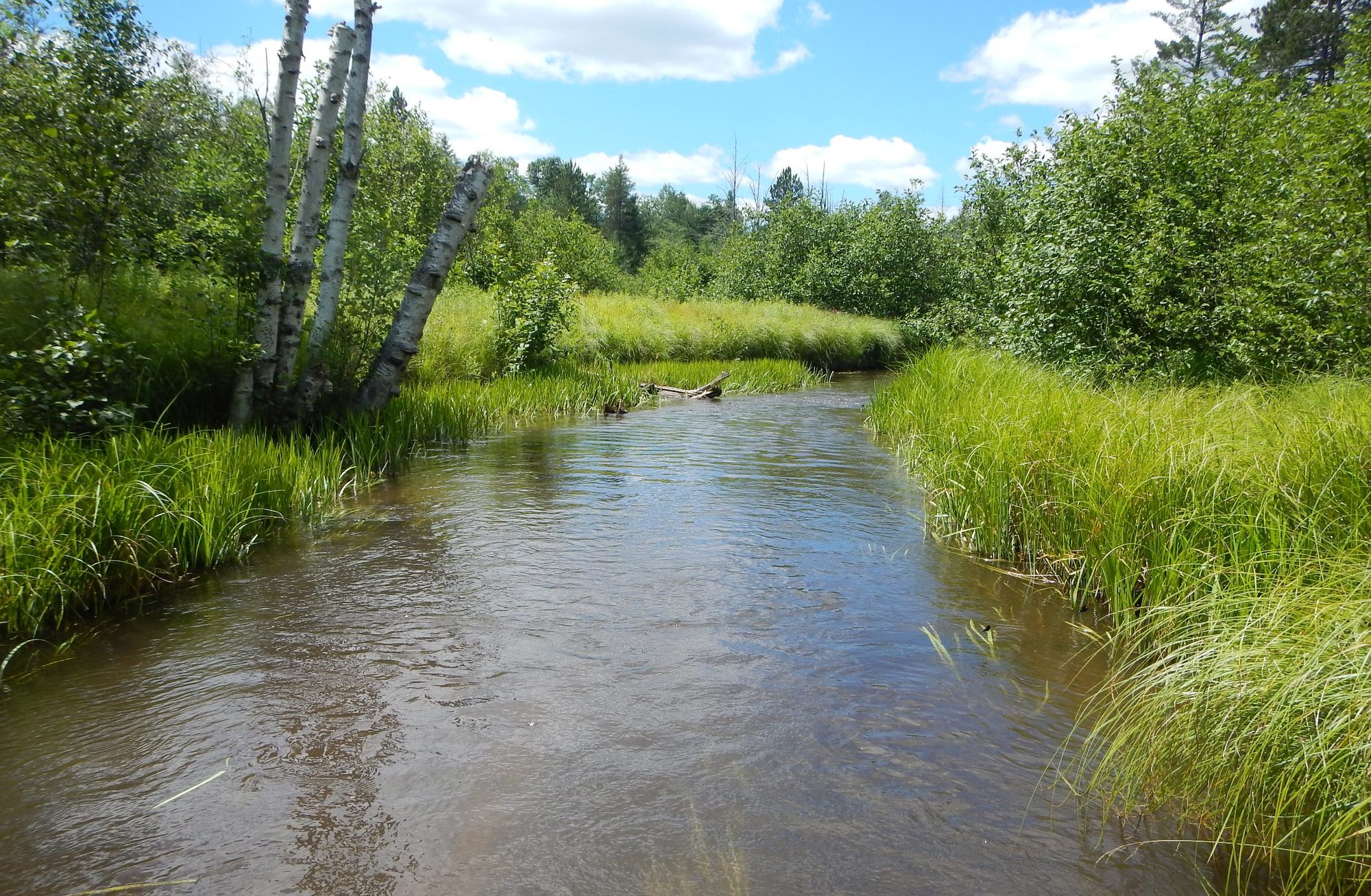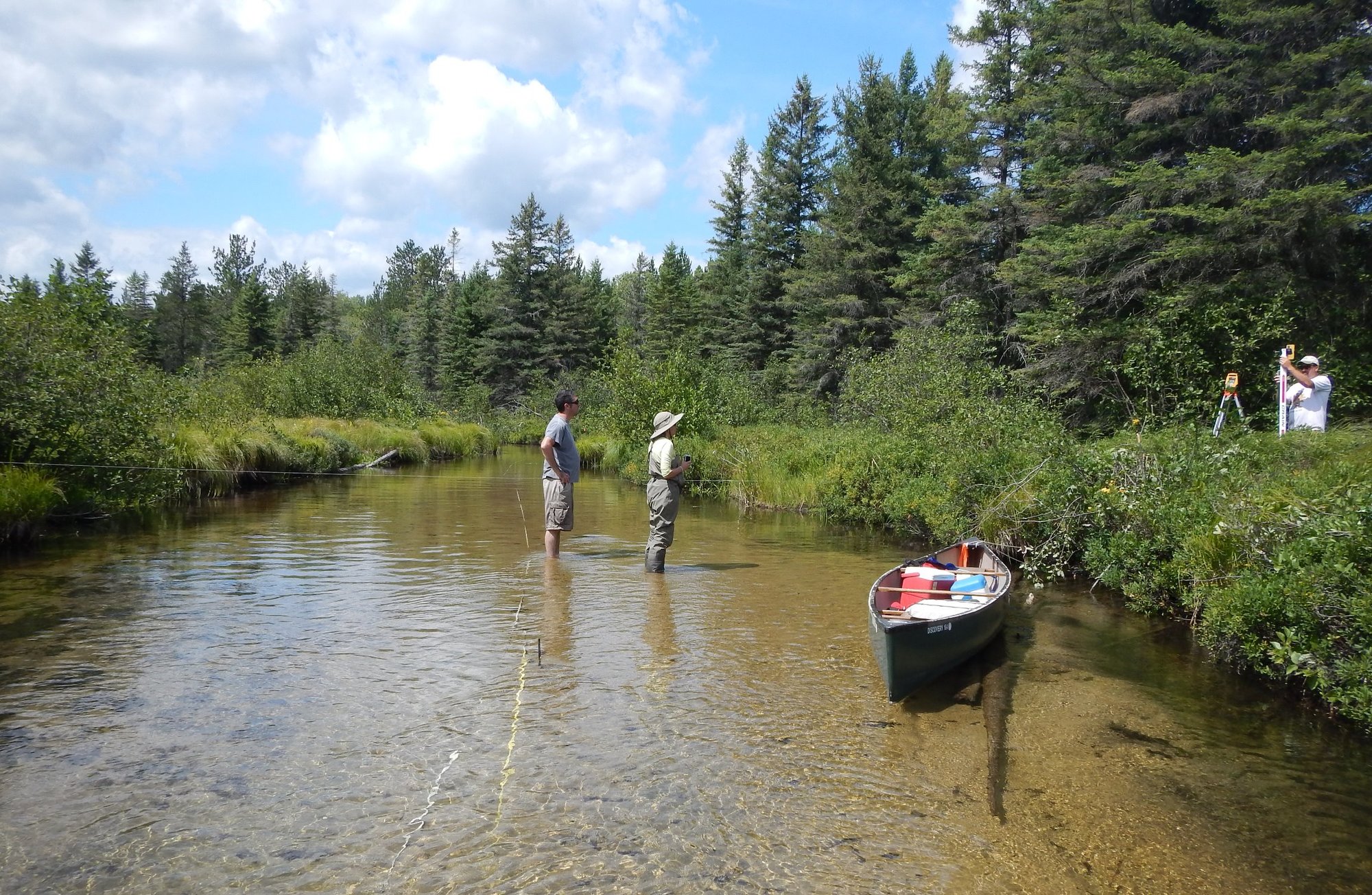Spring cleaning for streams beneficial to fish habitat
Anglers familiar with Michigan’s rivers in springtime know their steelhead fishing may be inconvenienced by swollen streams, with waters rising up to the top of the riverbanks, making access more difficult.
However, Michigan Department of Natural Resources fisheries personnel say this high water, while causing temporary problems for anglers, actually provides essential benefits to fish habitat.
“Springtime is when your favorite river is most likely to fill its banks or even flood,” said Chris Freiburger, a DNR natural resource manager. “During this periodic flooding, each river may have what is known as a ‘bankfull event.’”
Bankfull discharge
Bankfull discharge is the quantity of water – usually measured in cubic feet per second – it takes to fill a river’s banks to just before the point of flooding.
This flow, which varies in each river, is important to continued development of the shape and size of a river. Bankfull conditions typically occur, on average, about once every 1 ½ to 2 ½ years. Bankfull conditions typically occur, on average, about once every 1 ½ to 2 ½ years.
“These floods may temporarily stall fishing plans, but they are vitally necessary to rejuvenating the habitats our favorite fish require,” Freiburger said.
During bankfull flows, the river is moving water, woody material, flushing sand and rolling pebbles and stones that make up the river bottom and banks.
“Whether it’s gravel for salmon, walleye or smallmouth spawning, or the logs and branches that provide cover for monster brown trout, bankfull events are the river function that creates and sustains these natural habitats,” said Patrick Ertel, of the DNR Fisheries Division’s Habitat Management Unit.
As the water begins to rise in a river, there is more and more pressure placed on the bottom of the river. The increase in water depth “pushes” harder down on the river bed (or substrate).
“This force will cause the sand and gravel to really get moving,” Freiburger said. ”Once the river reaches its floodplain, the flow of the water spreads out, which is why the most ‘work’ done by a stream to its own channel is during the bankfull discharge, just before flooding.”
Flood stage
Flows higher than bankfull, during flood stage, will spill out onto the river’s floodplain – those large, flat expanses of land that generally run parallel to a river or valley.
When a flood reaches the floodplain, the water slows down and the stream can dissipate energy, leading to depositing of sand and other sediment.
“With the stream now out of its banks, it will take rather large inputs of water to increase the height of the flood versus when the stream is still confined by its banks,” Freiburger said.
 Variations Variations
It is important to keep in mind that what constitutes a bankfull flow is different for every single river in Michigan.
Though our state’s watersheds have similarities based on the region, they each have their own factors controlling bankfull flows including geology (soil types and groundwater), weather patterns (snow melt versus heavy rainfall storms) and land use (how impervious surfaces like cement and blacktop prevent infiltration of precipitation).
These factors also control water temperature, substrate size and habitat types available, which determine the species of fish that live in each river.
Working rivers
Floods also lift and float chunks of wood that have fallen into the stream and move them around to new locations. This redistributes woody material and sediment throughout the river channel as the water flows toward the Great Lakes, ultimately creating another unique habitat in river mouths.
“Think of the river as one big conveyer belt, moving sediment, habitat and nutrients to the lakes from the uplands,” Ertel said. “It is not one direction though. Rivers, when they’re not blocked by dams or undersized culverts, provide an avenue for fish and wildlife to migrate upstream, back to the headwaters.
“Even in locations away from the channel, the river can redistribute nutrients and materials in the riparian zones and floodplains. This creates unique habitats such as backwatered ponds and linear wetland features.
Balance
Of course, all of this is what happens in a healthy river. There are many rivers in our state that need customized help to get back to properly accommodating its bankfull flow.
When a river is out of balance with how it moves a bankfull flow, several things can happen. Maybe, the river moves too much sediment and erodes banks or exports the gravel many fish need for spawning. Perhaps the river cannot move enough sediment and the sand buries gravel or fills pools that provide deep water refuge. This can leave fish without important cover from predators. moves too much sediment and erodes banks or exports the gravel many fish need for spawning. Perhaps the river cannot move enough sediment and the sand buries gravel or fills pools that provide deep water refuge. This can leave fish without important cover from predators.
Another problem occurs when rivers cannot access their floodplains and they carve farther into the stream bottom, causing increased bed and bank erosion.
“Understanding what is happening in each river allows for the appropriate solution to be developed,” Freiburger said. “There is no perfect fix that works on every river.”
River assistance
The DNR has numerous partners across the state working to help rivers.
“From nonprofit organizations to small homeowners associations or private businesses and local governments, people care about our rivers and actively work to protect them,” said Jessica Mistak, supervisor of the DNR Fisheries Division’s Habitat Management Unit. “They are diligently learning about their favorite rivers, what the conditions should be and how to best fix them.”
Fixing rivers could involve stabilizing erosion sites, adding instream habitat, removing dams, replacing undersized culverts, treating invasive species, properly managing upland habitat, minimizing impervious surfaces, cleaning up rivers and more.
One of the roles of DNR’s Fisheries Division is to provide guidance to these active groups to ensure the projects are in line with the goals in place for managing each river.
Projects are being planned, reviewed and permitted every day. Perhaps you’re already involved in a project just around the corner.
In the meantime, as you’re chasing that elusive steelhead, eyeballing a logjam for the hex hatch or feeling the soft sand and gravel moving under your feet, take comfort in the fact that you are witnessing the river going through its spring cleaning.
Influenced by the weather, a healthy river continually renews its habitat resulting in better fishing opportunities for those enjoying Michigan’s natural resources.
Get more information on fishing in Michigan.
Catch upcoming stories by subscribing to free, weekly “Showcasing the DNR” articles. Check out previous Showcasing articles.
/Note to editors: Contact: Patrick Ertel, 989-732-3541. Accompanying photos are available below for download and media use. Suggested captions follow. Credit: Michigan Department of Natural Resources.
Boat: Tim Cwalinski, a senior fisheries biologist with the DNR, Nico Tucker, of the Northeast Michigan Council of Governments and Carol Rose of the Upper Black River Council, measuring a riffle cross-section on Canada Creek, Montmorency County.
Logs: On Klacking Creek in Ogemaw County there is a vast floodplain. As soon as flows get much higher than bankfull here, energy is quickly dissipated.
Stream: Sediment deposits quickly become vegetated, sometimes even below bankfull stage, as can be seen here on West Branch Big Creek, Otsego County.
Vest: Neal Godby, DNR Senior Fisheries Biologist, measures the streambed elevation of West Branch Big Creek, in Crawford County, to assess stream stability, by determining if the stream has good access to the bankfull bench, seen behind him.
Wading: DNR senior fisheries biologist Tim Cwalinski helps Nico Tucker, of the Northeast Michigan Council of Governments and Carol Rose of the Upper Black River Council gather pertinent stream data – including bankfull elevations – used in reviewing the effectiveness of in-stream habitat enhancement projects.
Additional photos: Chris Freiburger, Jessica Mistak and Patrick Ertel/
The Michigan Department of Natural Resources is committed to the conservation, protection, management, use and enjoyment of the state’s natural and cultural resources for current and future generations. For more information, go to www.michigan.gov/dnr.
|